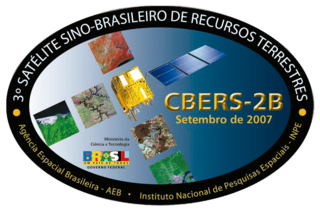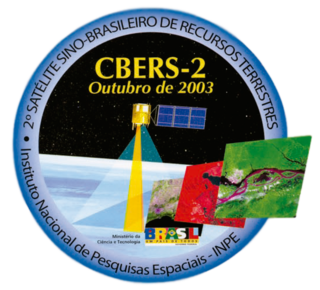
Envisat is a large Earth-observing satellite which has been inactive since 2012. It is still in orbit and considered space debris. Operated by the European Space Agency (ESA), it was the world's largest civilian Earth observation satellite.

The Blue Marble is a photograph of Earth taken on December 7, 1972, from a distance of around 29,400 kilometers from the planet's surface. Taken by the crew of the Apollo 17 spacecraft on its way to the Moon, it is one of the most reproduced images in history. The image has the official NASA designation AS17-148-22727.

Landsat 7 is the seventh satellite of the Landsat program. Launched on 15 April 1999, Landsat 7's primary goal is to refresh the global archive of satellite photos, providing up-to-date and cloud-free images. The Landsat program is managed and operated by the United States Geological Survey, and data from Landsat 7 is collected and distributed by the USGS. The NASA WorldWind project allows 3D images from Landsat 7 and other sources to be freely navigated and viewed from any angle. The satellite's companion, Earth Observing-1, trailed by one minute and followed the same orbital characteristics, but in 2011 its fuel was depleted and EO-1's orbit began to degrade. Landsat 7 was built by Lockheed Martin Space Systems.

DigitalGlobe was an American commercial vendor of space imagery and geospatial content, and operator of civilian remote sensing spacecraft. The company went public on the New York Stock Exchange on 14 May 2009, selling 14.7 million shares at US$19.00 each to raise US$279 million in capital. On 5 October 2017, Maxar Technologies completed its acquisition of DigitalGlobe.

Satellite images are images of Earth collected by imaging satellites operated by governments and businesses around the world. Satellite imaging companies sell images by licensing them to governments and businesses such as Apple Maps and Google Maps.
IKONOS was a commercial Earth observation satellite, and was the first to collect publicly available high-resolution imagery at 1- and 4-meter resolution. It collected multispectral (MS) and panchromatic (PAN) imagery. The capability to observe Earth via space-based telescope has been called "one of the most significant developments in the history of the space age", and IKONOS brought imagery rivaling that of military spy satellites to the commercial market. IKONOS imagery began being sold on 1 January 2000, and the spacecraft was retired in 2015.

Landsat 4 is the fourth satellite of the Landsat program. It was launched on July 16, 1982, with the primary goal of providing a global archive of satellite imagery. Although the Landsat Program is managed by NASA, data from Landsat 4 was collected and distributed by the U.S. Geological Survey. Landsat 4 science operations ended on December 14, 1993, when the satellite lost its ability to transmit science data, far beyond its designed life expectancy of five years. The satellite housekeeping telemetry and tracking continued to be maintained by NASA until it was decommissioned on June 15, 2001.
QuickBird was a high-resolution commercial Earth observation satellite, owned by DigitalGlobe, launched in 2001 and reentered after orbit decay in 2015. QuickBird used Ball Aerospace's Global Imaging System 2000. The satellite collected panchromatic imagery at 61 centimeter resolution and multispectral imagery at 2.44- to 1.63-meter resolution, as orbit altitude is lowered during the end of mission life.

GeoEye Inc. was an American commercial satellite imagery company based in Herndon, Virginia. GeoEye was merged into the DigitalGlobe corporation on January 29, 2013.
WorldView-1 is a commercial Earth observation satellite owned by DigitalGlobe. WorldView-1 was launched on 18 September 2007, followed later by the WorldView-2 in 2009. First imagery from WorldView-1 was available in October 2007, prior to the six-year anniversary of the launch of QuickBird, DigitalGlobe's previous satellite.

China–Brazil Earth Resources Satellite 2B (CBERS-2B), also known as Ziyuan 1-2B, was a remote sensing satellite operated as part of the China–Brazil Earth Resources Satellite program between the Chinese Center for Resources Satellite Data and Application and Brazilian National Institute for Space Research. The third CBERS satellite to fly, it was launched by China in 2007 to replace CBERS-2.

GeoEye-1 is a high-resolution Earth observation satellite owned by Maxar Technologies, launched in September 2008. The satellite was acquired in the 2013 purchase of GeoEye.
WorldView-4, previously known as GeoEye-2, was a third generation commercial Earth observation satellite launched on 11 November 2016, at 18:30:33 UTC. The spacecraft was operated by DigitalGlobe. With a maximum resolution of 31 cm (12 in), WorldView-4 provided similar imagery as WorldView-3, the highest resolution commercially available at the time of its launch.
WorldView-2 is a commercial Earth observation satellite owned by DigitalGlobe. WorldView-2 provides commercially available panchromatic imagery of 0.46 m (18 in) resolution, and eight-band multispectral imagery with 1.84 m (72 in) resolution.

China–Brazil Earth Resources Satellite 2 (CBERS-2), also known as Ziyuan I-02 or Ziyuan 1B, was a remote sensing satellite operated as part of the China–Brazil Earth Resources Satellite program between the Chinese Center for Resources Satellite Data and Application and Brazilian National Institute for Space Research. The second CBERS satellite to fly, it was launched by China in 2003 to replace CBERS-1.
IRS-1D is the seventh satellite in Indian Remote Sensing satellite series of Earth Observation satellites, built, launched and maintained by Indian Space Research Organisation (ISRO). The satellite has similar capabilities as that of ISRO's IRS-1C satellite with some improvements added for better imagery particularly in thematic mapping.
Rasad-1 was an Iranian satellite which was launched in 2011. The third Iranian satellite, and the second to be launched successfully using an indigenous rocket, Rasad-1 was Iran's first imaging satellite. Launched aboard a Safir-B carrier rocket, it was successfully placed into a low Earth orbit at an altitude of 236 by 299 kilometres, inclined at 55.7 degrees. It made approximately fifteen orbits per day.
SkySat is a constellation of sub-meter resolution Earth observation satellites owned by Planet Labs, providing imagery, high-definition video and analytics services. Planet acquired the satellites with their purchase of Terra Bella, a Mountain View, California-based company founded in 2009 by Dan Berkenstock, Julian Mann, John Fenwick, and Ching-Yu Hu, from Google in 2017.
Spaceflight Industries, Inc. is an American private aerospace company based out of Herndon, Virginia, that specializes in geospatial intelligence services. It sold its satellite rideshare business, Spaceflight, Inc., in June 2020.

Planet Labs PBC is an American public Earth imaging company based in San Francisco, California. Their goal is to image the entirety of the Earth daily to monitor changes and pinpoint trends.










